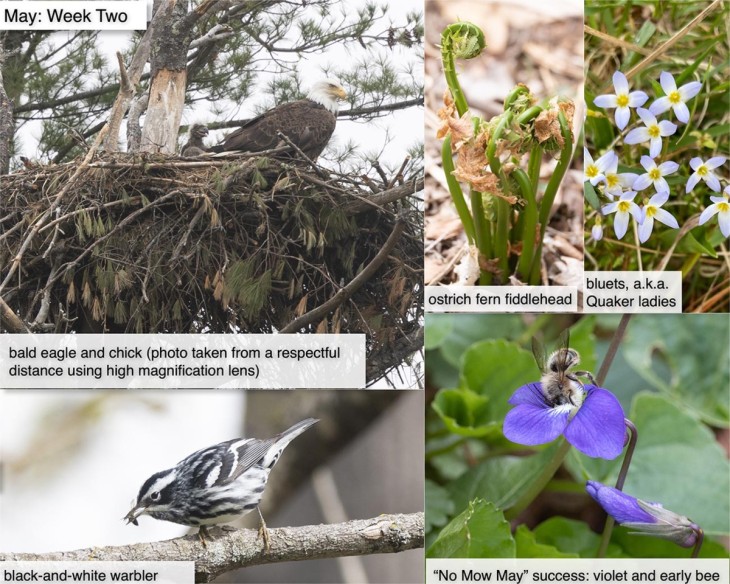This Week in the Woods, bald eagle chicks are growing quickly, and by this point, many have shed their white baby fuzz. The eaglet in this nest (photographed with a high magnification lens from across a marsh, to avoid stressing the birds) has mostly transitioned to its second, dark down phase, except that it’s still sporting a snazzy white hairdo. Eagle nests are massive stick structures, with some softer materials mixed in. They measure approximately 4 to 6 feet in diameter, can be a few feet deep, and weigh 1,000 pounds or more. No wonder trees sometimes crack under their weight.
Another welcome sign of spring is ostrich fern fiddleheads, which are relatively easy to distinguish from other emerging ferns because of the combination of “U” shaped grooves on their frond stems and the brown, paper-like casings that initially cover the fronds. Yet a third identifying trait is the plant’s feather-like fertile frond, which by spring is typically brown and snow-flattened, but still may be visible on the ground in an ostrich fern patch. Fiddleheads are a delicious spring treat, steamed or slightly cooked with a bit of salt and butter. However, as noted in this article from the spring 2021 issue of Northern Woodlands magazine, the plants are vulnerable to overharvesting. The good news is that it’s relatively easy to grow your own patch, and the ferns make attractive additions to gardens throughout the growing season.
Meghan McCarthy McPhaul photographed these bluets, also known as Quaker ladies, at the Chaffee Wildlife Sanctuary near the Northern Woodlands office. These tough little wildflowers begin blooming now, and left alone, can develop expansive patches, especially in moist soils with a mix of sun and shade. If you want to encourage bluets to spread, as noted by the Lady Bird Johnson Wildflower Center, “care should be taken not to mow them before they set seed.”
Another reason to hold off mowing is the benefit to pollinators. As you drive around the Upper Valley, you may notice “No Mow May” signs along roadsides – this is a campaign to boost early food supplies for bees and other pollinating insects. As noted in this Outside Story article by Tim Traver, nationwide, lawns cover tens of millions of acres of potential habitat. This space could, collectively, be a major boon for local insects, if lawns were simply a little less manicured, with less exposure to herbicides. This photo is from a lawn where the homeowners have taken a section out of mowing and are letting violets take over. The result is a noticeable increase in bees and early butterflies.
Finally, now is a great time to see and hear warblers, which have been migrating in to the region during the past few weeks. One of the easiest warblers to see, and also one of the earliest arriving, is the black-and-white warbler. A distinctive trait of this bird is that it routinely sticks its bill into tree bark to forage for insects, spiders, and other small prey. This is typical behavior for many of our all-year resident birds such as nuthatches and brown creepers, but isn’t normal feeding behavior for most warblers. Black-and-whites often nest in deciduous forest that has moved beyond its early successional phase. They’re not especially shy as warblers go. We found this bird catching insects along the woodsy edge of the Northern Woodlands’ backyard.
What have you noticed in the woods this week? Submit a recent photo for possible inclusion in our monthly online Reader Photo Gallery.


